Driving License Learning Online: A Comprehensive Guide
In today's busy world, the requirement of possessing a driving license can not be undervalued. view website of digitalization has actually changed the method individuals can get ready for their driving tests. Online learning platforms now offer a convenient and reliable ways of getting important knowledge and skills required to pass the driving test. This post will look into the different aspects of driving license learning online, including its advantages, how it works, and what to expect.
The Evolution of Driving License Education
Generally, acquiring a driving license involved attending physical classroom sessions together with behind-the-wheel training. Students had to manage traveling to classes and acquiring practical experience, which could be both time-consuming and tough. However, the intro of online learning has transformed this process, making it more available and flexible.
Benefits of Learning to Drive Online
Learning to drive online offers various benefits, consisting of:
- Flexibility: Learners can get ready for their tests at their own pace and convenience, without the rigid scheduling usually related to conventional classes.
- Cost-Effectiveness: Online courses often come at a lower cost compared to in-person guideline, making it an appealing choice for many.
- Access to Resources: Comprehensive online courses typically include simulations, tests, and instructional videos that improve the learning experience.
- Updated Information: Online materials are often updated more routinely, making sure learners get the most present information on traffic laws and regulations.
- Self-Paced Learning: Students can examine sections they discover difficult and progress through the product as they master each subject.
How Online Driving Education Works
Many online driving courses are structured to supply a comprehensive learning experience. Below are the common components of an online driving course:
1. Enlist in a Course
- Trainees select an online driving school that matches their requirements and register for a course.
2. Access Study Materials
- Upon enrollment, learners get to a portal containing study products, consisting of multimedia material, practice tests, and resources on state-specific traffic laws.
3. Study and Complete Instructional Modules
- Courses are broken down into modules that learners must finish. Many platforms offer video lectures, interactive tests, and reading products.
4. Take Practice Tests
- The majority of online learning platforms supply chances to take practice tests, mimicking the real composed driving test. This helps students assess their preparedness for the real exam.
5. Behind-the-Wheel Training
- While online courses concentrate on theoretical knowledge, students will still require practical driving practice. Most platforms recommend partnering with a knowledgeable chauffeur or registering in a local driving school for hands-on training.
6. Schedule the Driving Exam
- As soon as trainees feel great in their knowledge and abilities, they can set up a visit for the composed and driving tests with their local automobile department.
Table: Comparison of Online vs. Traditional Driving Learning
| Function | Online Driving Courses | Conventional Driving Schools |
|---|---|---|
| Versatility | High (research study at own pace) | Limited (fixed class schedule) |
| Cost | Generally lower | Generally higher |
| Learning Format | Self-directed multimedia | Instructor-led lectures |
| Research study Materials | Updated routinely | May not reflect the most recent laws |
| Behind-the-Wheel Guidance | Needs external arrangements | Consisted of in the package |
What to Expect from Online Driving Courses
While each online driving course might differ, learners can typically anticipate the following:
- Comprehensive Curriculum: Courses cover important subjects such as traffic laws, road indications, safe driving practices, and protective driving techniques.
- Interactive Learning: Many online courses carry out gamification techniques to make learning enjoyable and engaging.
- Assistance: A trustworthy online driving school should provide access to trainers by means of email, chat, or phone for extra support.
Regularly Asked Questions (FAQs)
1. Is online driving education acknowledged by all states?
While many states accept online driving courses for the written portion of the exam, policies might vary when it concerns the behind-the-wheel training. It is essential for trainees to verify their state's particular requirements.
2. Can I find out to drive without a physical class?
Yes, you can finish the theoretical part of driving education completely online; nevertheless, practical driving lessons with a knowledgeable grownup or a licensed trainer are crucial.
3. Are online driving tests the like in-person tests?
The format of online practice tests often resembles the real tests, however they might not always correspond the state-specific driving examinations. Nevertheless, they serve to acquaint students with the test structure and material.
4. Is online driving education suitable for all age groups?
Yes, online driving education is available and beneficial for students of any ages, whether young grownups preparing for their very first driving test or older grownups looking for to revitalize their abilities.
5. What occurs if I fail the online practice tests?
Failing a practice test is typical and should not prevent learners. The majority of online courses enable unlimited attempts to retake tests and tests till a passing grade is attained.
Learning to drive online provides a viable choice for many people looking to get their driving license in a flexible and economical manner. With the advancement of online education, people can now prepare for their driving tests with ease and confidence. As learners navigate this self-paced journey, they can gain from extensive resources, engaging content, and the benefit of handling their own schedules. Eventually, whether selecting online education or a traditional technique, the key stays the commitment to safe driving practices and compliance with local policies.

